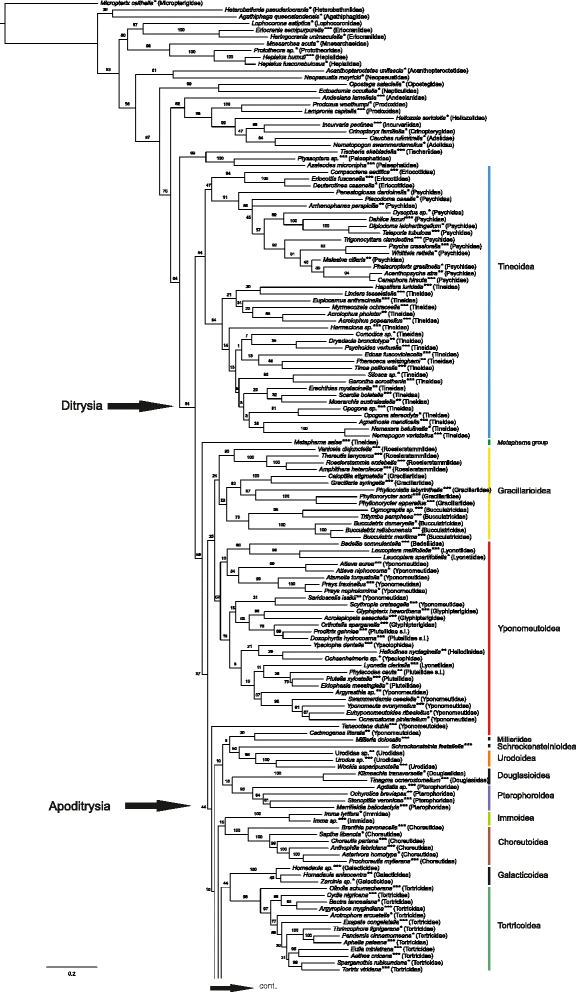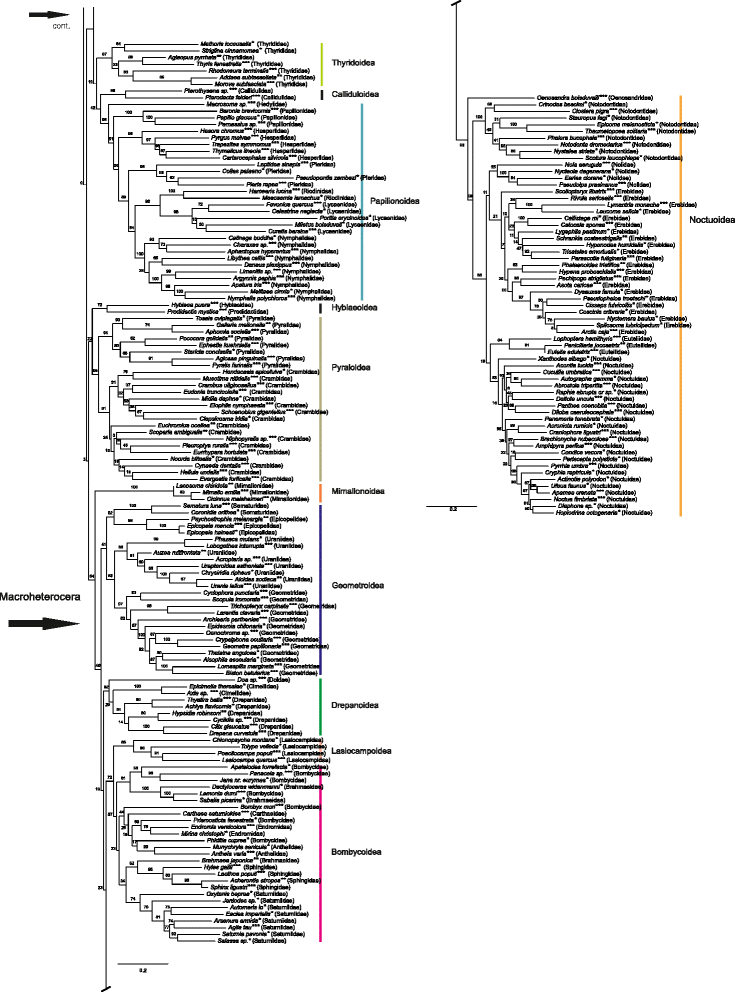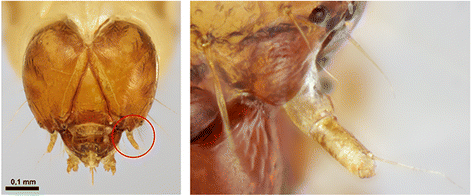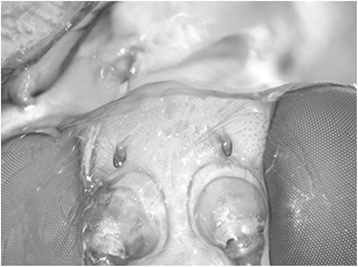Elusive ditrysian phylogeny: an account of combining systematized morphology with molecular data (Lepidoptera)
- PMID: 26589618
- PMCID: PMC4654798
- DOI: 10.1186/s12862-015-0520-0
Elusive ditrysian phylogeny: an account of combining systematized morphology with molecular data (Lepidoptera)
Abstract
Background: Ditrysia comprise close to 99 % of all butterflies and moths. The evolutionary relationships among the ditrysian superfamilies have received considerable attention in phylogenetic studies based on DNA and transcriptomic data, but the deepest divergences remain for large parts unresolved or contradictory. To obtain complementary insight into the evolutionary history of the clade, and to test previous hypotheses on the subdivision of Ditrysia based on morphology, we examine the morphology of larvae, pupae and adult males and females of 318 taxa representing nearly all ditrysian superfamilies and families. We present the most comprehensive morphological dataset on Ditrysia to date, consisting of over 500 morphological characters. The data are analyzed alone and combined with sequence data (one mitochondrial and seven nuclear protein-coding gene regions, sequenced from 422 taxa). The full dataset consists of 473 exemplar species. Analyses are performed using maximum likelihood methods, and parsimony methods for the morphological dataset. We explore whether combining morphological data and DNA-data can stabilize taxa that are unstable in phylogenetic studies based on genetic data only.
Results: Morphological characters are found phylogenetically informative in resolving apical nodes (superfamilies and families), but characters serving as evidence of relatedness of larger assemblages are few. Results include the recovery of a monophyletic Tineoidea, Sesioidea and Cossoidea, and a stable position for some unstable taxa (e.g. Epipyropidae, Cyclotornidae, Urodoidea + Schreckensteinioidea). Several such taxa, however, remain unstable even though morphological characters indicate a position in the tree (e.g. Immidae). Evidence supporting affinities between clades are suggested, e.g. a novel larval synapomorphy for Tineidae. We also propose the synonymy of Tineodidae with Alucitidae, syn. nov.
Conclusions: The large morphological dataset provides information on the diversity and distribution of morphological traits in Ditrysia, and can be used in future research on the evolution of these traits, in identification keys and in identification of fossil Lepidoptera. The "backbone" of the phylogeny for Ditrysia remains largely unresolved. As previously proposed as an explanation for the scarcity of molecular signal in resolving the deeper nodes, this may be due to the rapid radiation of Ditrysia in the Cretaceous.
Figures









Similar articles
-
Toward reconstructing the evolution of advanced moths and butterflies (Lepidoptera: Ditrysia): an initial molecular study.BMC Evol Biol. 2009 Dec 2;9:280. doi: 10.1186/1471-2148-9-280. BMC Evol Biol. 2009. PMID: 19954545 Free PMC article.
-
Comprehensive gene and taxon coverage elucidates radiation patterns in moths and butterflies.Proc Biol Sci. 2010 Sep 22;277(1695):2839-48. doi: 10.1098/rspb.2010.0392. Epub 2010 May 5. Proc Biol Sci. 2010. PMID: 20444718 Free PMC article.
-
A large-scale, higher-level, molecular phylogenetic study of the insect order Lepidoptera (moths and butterflies).PLoS One. 2013;8(3):e58568. doi: 10.1371/journal.pone.0058568. Epub 2013 Mar 12. PLoS One. 2013. PMID: 23554903 Free PMC article.
-
Phylogenomic data exploration with increased sampling provides new insights into the higher-level relationships of butterflies and moths (Lepidoptera).Mol Phylogenet Evol. 2024 Aug;197:108113. doi: 10.1016/j.ympev.2024.108113. Epub 2024 May 23. Mol Phylogenet Evol. 2024. Retraction in: Mol Phylogenet Evol. 2025 Jan;202:108251. doi: 10.1016/j.ympev.2024.108251. PMID: 38796071 Retracted.
-
Increased gene sampling strengthens support for higher-level groups within leaf-mining moths and relatives (Lepidoptera: Gracillariidae).BMC Evol Biol. 2011 Jun 24;11:182. doi: 10.1186/1471-2148-11-182. BMC Evol Biol. 2011. PMID: 21702958 Free PMC article.
Cited by
-
A supertree of Northern European macromoths.PLoS One. 2022 Feb 18;17(2):e0264211. doi: 10.1371/journal.pone.0264211. eCollection 2022. PLoS One. 2022. PMID: 35180261 Free PMC article.
-
The mitochondrial genome of the steppe carpenter moth (Paracossulus thrips Hübner, 1818): Structural analysis and phylogenetic implications.Sci Rep. 2025 Mar 11;15(1):8393. doi: 10.1038/s41598-025-93646-6. Sci Rep. 2025. PMID: 40069326 Free PMC article.
-
First mitochondrial genome from Yponomeutidae (Lepidoptera, Yponomeutoidea) and the phylogenetic analysis for Lepidoptera.Zookeys. 2019 Oct 9;879:137-156. doi: 10.3897/zookeys.879.35101. eCollection 2019. Zookeys. 2019. PMID: 31636502 Free PMC article.
-
The trinity of ecological contrasts: a case study on rich insect assemblages by means of species, functional and phylogenetic diversity measures.BMC Ecol. 2020 May 10;20(1):29. doi: 10.1186/s12898-020-00298-3. BMC Ecol. 2020. PMID: 32389122 Free PMC article.
-
The giant butterfly-moth Paysandisia archon has spectrally rich apposition eyes with unique light-dependent photoreceptor dynamics.J Comp Physiol A Neuroethol Sens Neural Behav Physiol. 2018 Jul;204(7):639-651. doi: 10.1007/s00359-018-1267-z. Epub 2018 Jun 4. J Comp Physiol A Neuroethol Sens Neural Behav Physiol. 2018. PMID: 29869100 Free PMC article.
References
-
- van Nieukerken EJ, Kaila L, Kitching IJ, Kristensen NP, Lees DC, Minet J, et al. Animal biodiversity: An outline of higher-level classification and survey of taxonomic richness. Zootaxa. 2011;3148:212–21.
-
- Kristensen NP, Skalski AW. Phylogeny and palaeontology. In: Kristensen NP, editor. Handbook of Zoology IV: Lepidoptera, moths and butterflies. Vol.1: Evolution, systematics and biogeography. Berlin, New York: Walter de Gruyter; 1999. pp. 7–25.
-
- Minet J. Ebauche d’une classification moderne de l’ordre des lépidoptères. Alexanor. 1986;14:291–313.
-
- Minet J. Tentative reconstruction of the ditrysian phylogeny (Lepidoptera, Glossata) Entomol Scand. 1991;22(1):69–95. doi: 10.1163/187631291X00327. - DOI
-
- Karsholt O, Nielsen PS. Revised Checklist of the Lepidoptera of Denmark. Lepidopterologisk Forening: København; 2013.
Publication types
MeSH terms
LinkOut - more resources
Full Text Sources
Other Literature Sources
Research Materials
Miscellaneous

